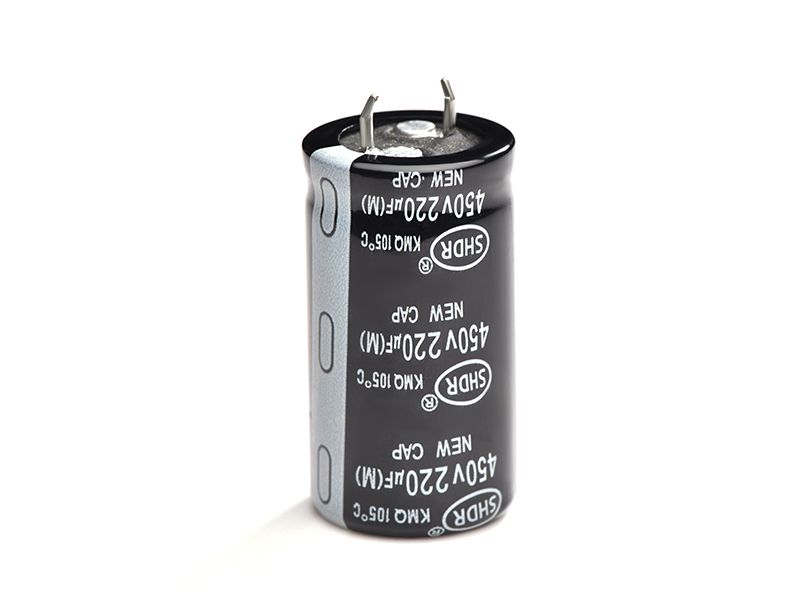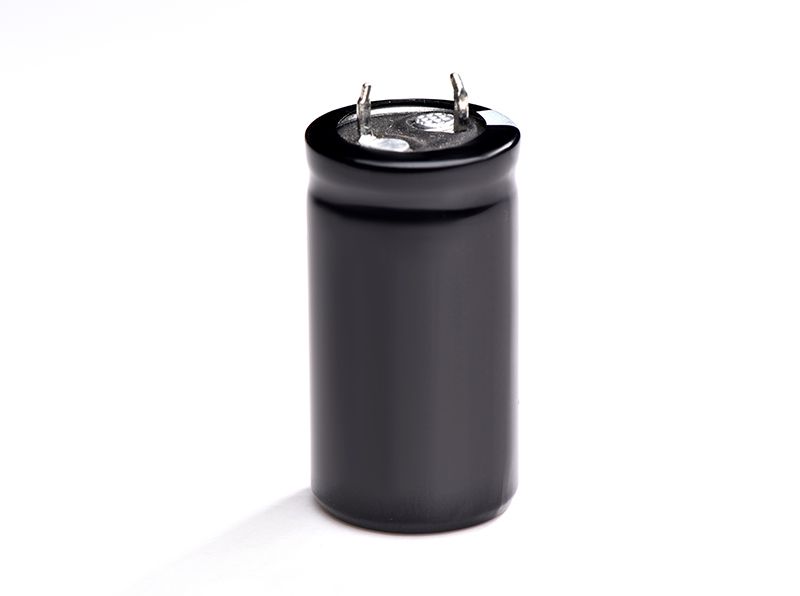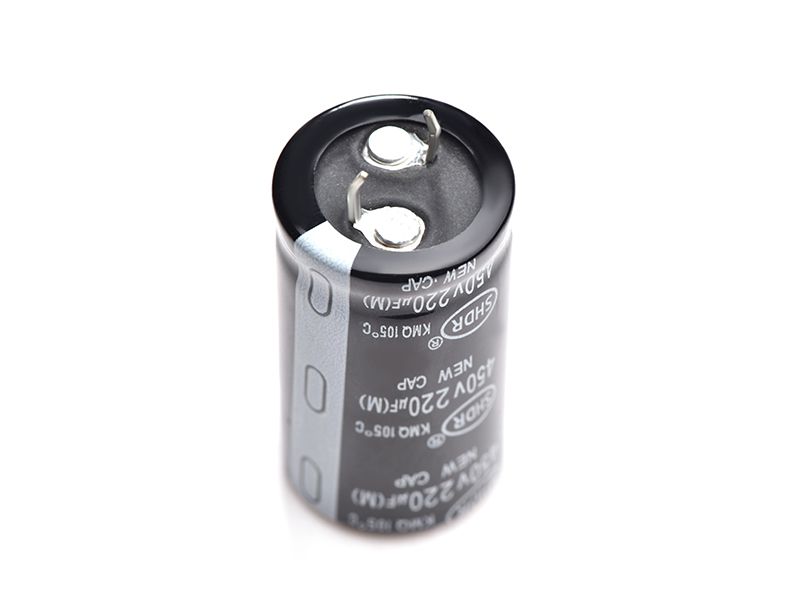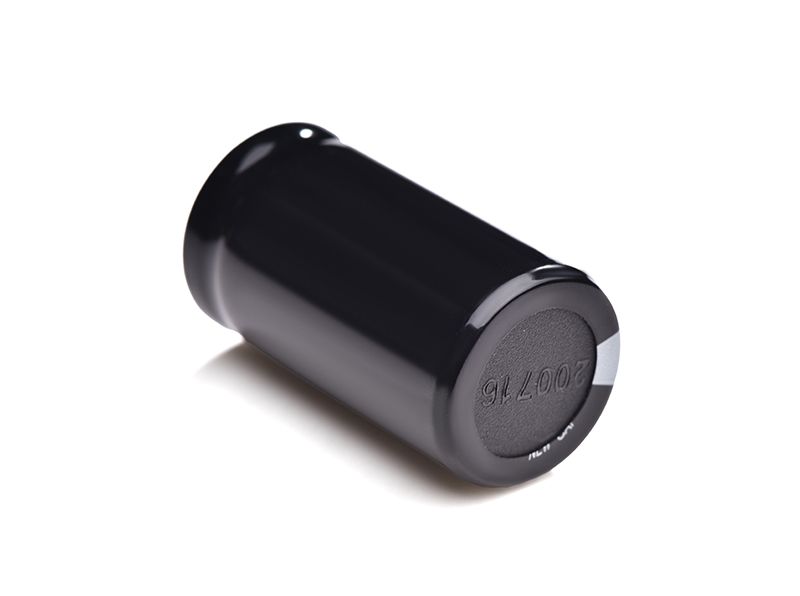220uf450v Snap-in Electrolytic Capacitor
SHDR® Application Notes
surge voltage
When the circuit is struck by lightning and when the inductive load or large load is connected or disconnected, a high operating overvoltage is often generated. This instantaneous overvoltage (or overcurrent) is called surge voltage (or surge current), which is a A transient disturbance. For example, when the DC 6V relay coil is disconnected, there will be a surge voltage of 300V to 600V; when the incandescent lamp is connected, there will be a surge current of 8 to 10 times the rated current; when a large capacitive load such as a compensation capacitor bank is connected, the There is a large surge current impact, which causes the power supply voltage to drop suddenly; when the no-load transformer is cut off, an operating overvoltage as high as 8 to 10 times the rated voltage will also occur. The phenomenon of surge voltage is increasingly seriously endangering the safe operation of automation equipment. Eliminating surge noise interference and preventing surge damage has always been the core issue related to the safe and reliable operation of automation equipment. The degree of integration of modern electronic devices is increasing, but their ability to withstand surge voltages is decreasing. In most cases, surge voltages can damage circuits and their components, and the degree of damage is closely related to the compressive strength of the components and to the amount of energy that can be converted in the circuit.
Chinese name
surge voltage
time
The moment the power is turned on
belong
Peak current flowing into the power supply
reason
Short-term high voltage like a "wave"
fast
navigation
Hazardous surge protection
cause
A surge is also called a surge, which is an instantaneous overvoltage that exceeds the normal voltage. It generally refers to a large current caused by a short-term "surge"-like high voltage in the power grid. Essentially, a surge is a violent pulse that occurs in just one millionth of a second. There are two reasons for the surge voltage, one is lightning, and the other is generated when the large load on the grid is turned on or off (including the switching of compensation capacitors).
(1) Lightning is an extremely strong electromagnetic transient process that occurs in nature. Mainly through two channels to affect the power automation equipment. One is that the lightning directly hits the lightning rod and lightning protection line of the substation or dispatching center, and the generated transient electromagnetic field has the electromagnetic effect on the electronic equipment in the surrounding space, which generates piezoelectric current on the closed metal circuit and induces the electromotive force on the open metal circuit. Due to the strong effects of lightning electromagnetic pulses, the induced voltages can be very high. The lightning current leaked into the ground through the ground wire causes the voltage of the ground network to rise, resulting in a large voltage difference between the grounding points in the grounding system. They may cause interference to the automation equipment, affecting the normal operation in light cases, and in serious cases. can cause equipment damage. Second, the lightning discharge between the thunderclouds above the line, or the discharge to the ground near the line, will cause the line to generate lightning shock waves or surge voltages due to electromagnetic induction. equipment, causing work errors or equipment damage. If the lightning strikes the line directly, the surge voltage will be stronger and more harmful.
(2) When some large-capacity electrical equipment is turned on or off, due to the existence of inductance in the power grid, a "surge voltage" will be generated in the power grid, thereby causing a surge current. Generally, no matter the size of the equipment, there will be a surge voltage. The problem is that the surge voltage generated by the small-capacity equipment is small and will not cause much harm, so it is often ignored by people. During the start-up of the off-line converter, a large current is generated due to the charging of the bulk capacitors. This large current is several times or even dozens of times larger than the normal current of the system (the so-called inrush current), which may cause the voltage of the AC line to drop, thereby affecting the operation of all devices connected to the same AC line, and sometimes blowing out Components such as fuses and rectifier diodes. The diversity of operation modes and fault forms determines the different categories of operating overvoltage, mainly including arc grounding overvoltage in ungrounded neutral system, closing overvoltage of no-load line, no-load line, no-load bus and Breaking capacitive load overvoltage when capacitors are switched off, switching inductive load overvoltages when no-load transformers, reactors and motors are switched off, etc. [1]
harm
Surge includes surge surge, current surge, and power surge, which can be divided into surges caused by lightning strikes and operational surges generated inside the electrical system. The surge that appears in the building ranges from nearly kV to several tens of kV. If it is not limited, it will cause: malfunction of electronic equipment; damage to power supply equipment and valuable computers and various hardware equipment, resulting in direct economic losses; There are hidden hidden dangers left in the electronic chip, which make the electronic equipment run unstable and accelerate aging.
Nowadays, people pay more and more attention to the impact of surge voltage on manufacturing systems and information systems. This is mainly because the core of modern industry is automation, and automation relies on computers (usually PLC, which is a general-purpose industrial computer) to control. Computers are very sensitive to surge voltages. Surge voltage is the main cause of computer malfunction and data loss. Surge voltage can also cause soft damage to the computer. Soft damage means that the reliability of the computer is reduced and its life is shortened after the surge voltage is applied. The failures of modern manufacturing systems caused by surge voltages mainly include:
(1) Loss of data in memory
(2) The I/O interface circuit is reset, causing the control process to be interrupted
(3) The device on the circuit board is damaged
(4) Preset calibration value drift
(5) The program runs away and the system deadlocks
(6) The input rectifier module of the inverter, DC motor driver, etc. is faulty
(7) The controller issues an incorrect command, causing the system to malfunction
surge protection
Surge protection is a problem that must be considered in modern manufacturing systems and information systems. It's important to note that the standards for surge protection have also changed dramatically. Traditional surge protection measures only need to protect the insulation of electrical equipment from being damaged by surge voltages. The modern surge protection measures should ensure that the control system and information system will not malfunction under the condition of surge voltage. Recently, a major accident on a high-speed rail was said to be caused by bad weather, which caused the signal system to malfunction. It is possible that the surge voltage caused by lightning makes the signal system malfunction. Therefore, protection against surge voltages must be fully considered during the integration of modern automatic systems. Devices that can provide reliable surge protection for automatic control systems and information systems are called "sine wave tracking surge protectors". Using this kind of equipment can not only protect the insulation of electrical equipment from damage, but also ensure the reliable operation of control equipment and information equipment. Investments in surge protection have proven to pay off quickly by reducing equipment damage, lowering maintenance costs, increasing system uptime, and more. From the perspective of maintaining the safe and reliable operation of the system, it is necessary to install a surge protector.
Surge voltage protection mechanism
The basic requirements of surge voltage protection are: when there is no interference in the circuit, it will not affect the normal operation of the equipment; once there is a surge voltage intrusion in the working circuit, the surge voltage should be suppressed within the acceptable threshold range of the equipment to ensure that the equipment is not affected. normal operation during surge disturbances and prevent damage to circuit components and systems. From the perspective of circuit connection relationship, there are two ways of protection. One is to disconnect the device from the disturbed working circuit, and the other is to provide a discharge channel for the surge voltage, so that the surge voltage does not affect the receiver. on the protected device. Because the electrical performance of the protection device is completely different when the system is working normally and when the surge is disturbed, the volt-ampere characteristic of the protection device must have strong nonlinear characteristics. For general components, their resistance basically does not change with the change of operating conditions, and their volt-ampere characteristics show good linear characteristics.
There is a type of component, when the voltage difference between its two ends is within the normal range, the resistance is very large, and almost no current flows; once the voltage difference between the two ends of the component increases to a certain threshold value, the resistance decreases rapidly and is almost zero. The use of such components can be made into a parallel type surge protector, thus protecting the equipment. In fact, the protector cannot be completely short-circuited when the surge invades, and the voltage at both ends cannot reach zero. It can only reach a small value, which is called the clamping voltage. The safe voltage can effectively protect the equipment.
Another type of component has the opposite nonlinear characteristics. Under normal operating voltage, the resistance is almost completely zero. When the control voltage (signal voltage or power supply voltage) reaches a certain threshold value, the component immediately presents a large resistance value. , the use of such components can be made into series surge protector. Because of its high impedance state, the circuit is equivalent to a disconnection, which protects the protected equipment from the intrusion of the surge voltage.
According to the basic method of DBSG proposed by IEC organization, the following six technical measures should be taken to protect electronic information system from lightning and surge: (1) direct lightning protection, (2) shielding and isolation, (3) reasonable wiring, (4) Equipotential bonding, (5) common grounding, (6) install and use surge protector. In a perfect lightning protection project of electronic information system, these six protection measures should be considered. But at present the weakest is the installation and use of surge protector (SPD). [2][1]
surge protector
Surge protector (SPD) is a device used to limit transient overvoltage and discharge corresponding transient overcurrent to protect the safety of electronic and electrical equipment, also known as surge protector (or lightning protection device, lightning protection device) , arresters, etc.). It should contain at least one nonlinear element. A surge protector is actually an equipotential connector. By using the surge protector scientifically and rationally for a protected system, all the equipment ports in the system with the surge protector installed can achieve voltage equalization or mutual equipotentiality at the moment of lightning and surge impact, thereby avoiding the internal Harmful instantaneous potential difference, to ensure the safe operation of the entire system.
The current surge protectors are mainly composed of gas discharge tubes, solid discharge tubes, discharge gaps, varistors, fast recovery diodes, transient suppression diodes, thyristors, thermal fuses, fast fuses, high and low pass filters and other devices. Voltage, current, power, frequency, transmission rate, standing wave coefficient, insertion loss, bandwidth, impedance and other requirements are made by different forms of circuits. Surge protectors are generally divided into two categories: (1) power surge protectors (can be divided into AC and DC surge protectors) (2) signal surge protectors (can be divided into process control, general signal and antenna feeder line surge protector)
The schematic diagram of the class of withstand impulse voltage of AC power distribution system and the classification protection with surge protector is as follows:
Since the energy of the lightning strike is very huge, it is necessary to discharge the energy of the lightning strike to the ground gradually through the method of graded discharge. The first-level lightning protection device can discharge the direct lightning current, or discharge the huge energy conducted when the power transmission line is directly struck by lightning. For places where direct lightning strikes may occur, CLASS-I lightning protection must be carried out. The second-level lightning arrester is a protective device for the residual voltage of the previous-level lightning arrester and the induced lightning strike in the area. When the front-level lightning strike energy absorption occurs, there is still a part of the equipment or the third-level lightning protection device. It is quite a huge amount of energy that will be transmitted over, which requires further absorption by the second-level lightning arrester. At the same time, the transmission line passing through the first-level lightning protection device will also induce the lightning strike electromagnetic pulse radiation LEMP. When the line is long enough, the energy of the induced lightning becomes large enough, and the second-level lightning protection device is required to further discharge the lightning strike energy. The third-level lightning arrester protects the LEMP and the residual lightning strike energy passing through the second-level lightning arrester.
1. The first level of protection
The purpose is to prevent the surge voltage from being conducted directly from the LPZ0 area into the LPZ1 area, and to limit the surge voltage of tens of thousands to hundreds of thousands of volts to 2500-3000V. The power supply lightning arrester installed on the low-voltage side of the household power transformer should be a three-phase voltage switching type power supply lightning protection device as the first-level protection, and its lightning current flow should not be lower than 60KA. This level of power surge arrester should be a large-capacity power surge arrester connected between each phase of the incoming line of the user's power supply system and the ground. Generally, this level of power lightning arrester is required to have a maximum impact capacity of more than 100KA per phase, and the required limit voltage is less than 1500V, which is called CLASS I power lightning protection device. These electromagnetic arresters are designed to withstand the high currents of lightning and induced lightning strikes and to attract high-energy surges, diverting large surge currents to earth. They only provide limited voltage (when the surge current flows through the power surge arrester, the maximum voltage that appears on the line is called limiting voltage) as a medium level of protection, because the CLASS I level protector mainly absorbs large surge currents, only They cannot fully protect the sensitive electrical equipment inside the power supply system. The first-level power lightning arrester can prevent lightning waves of 10/350μs and 100KA, reaching the highest protection standard specified by IEC. Its technical reference is: lightning current flow is greater than or equal to 100KA (10/350μs); residual voltage value is not greater than 2.5KV; response time is less than or equal to 100ns.
2. The second level of protection
The purpose is to further limit the value of the residual surge voltage through the first-level lightning arrester to 1500-2000V, and implement equipotential bonding for LPZ1-LPZ2. As the second-level protection, the power surge arrester output by the distribution cabinet line should be a voltage-limiting power surge arrester, and its lightning current capacity should not be less than 20KA. Circuit Distribution Office. These power surge arresters can better absorb the residual surge energy that has passed through the surge arrester at the user's power supply inlet, and have an excellent suppression effect on transient overvoltage. The maximum impact capacity required by the power surge arrester used here is more than 45kA per phase, and the required limiting voltage should be less than 1200V, which is called CLASS II power surge arrester. The general user power supply system can meet the requirements of the operation of the electrical equipment if the second-level protection is achieved. The second-level power lightning arrester adopts C-type protector for phase-to-neutral, phase-to-earth and middle-to-earth full-mode protection. The main technical parameters are: lightning current capacity greater than or equal to 40KA (8/20μs); residual voltage The peak value is not more than 1000V; the response time is not more than 25ns.
3. The third level of protection
The purpose is to ultimately protect the equipment by reducing the value of the residual surge voltage to less than 1000V, so that the energy of the surge can cause damage to the equipment. When the power lightning arrester installed at the AC power inlet end of the electronic information equipment is used as the third-level protection, it should be a series voltage limiting type power supply lightning protection device, and its lightning current capacity should not be lower than 10KA. The last line of defense can be a built-in power surge arrester in the power supply part of the electrical equipment to achieve the purpose of completely eliminating tiny transient overvoltages. The maximum impulse capacity required by the power lightning arrester used here is 20KA or lower per phase, and the required limiting voltage should be less than 1000V. It is necessary to have the third-level protection for some particularly important or sensitive electronic equipment, and it can also protect the electrical equipment from the transient overvoltage generated inside the system. For the rectified power supply used in microwave communication equipment, mobile station communication equipment and radar equipment, it is advisable to select a DC power surge arrester with an adapted working voltage as the final protection according to the protection requirements of its working voltage.
4. Level 4 and above protection
According to the withstand voltage level of the protected equipment, if the two-level lightning protection can limit the voltage to be lower than the withstand voltage level of the equipment, only two levels of protection are required. If the withstand voltage level of the equipment is low, four levels or even More levels of protection. The lightning current capacity of the fourth-level protection should not be lower than 5KA.
Product Picture




Copyright © Guangzhou Shenghe Electronic Technology Co., Ltd. All Rights Reserved Sitemap | Powered by
